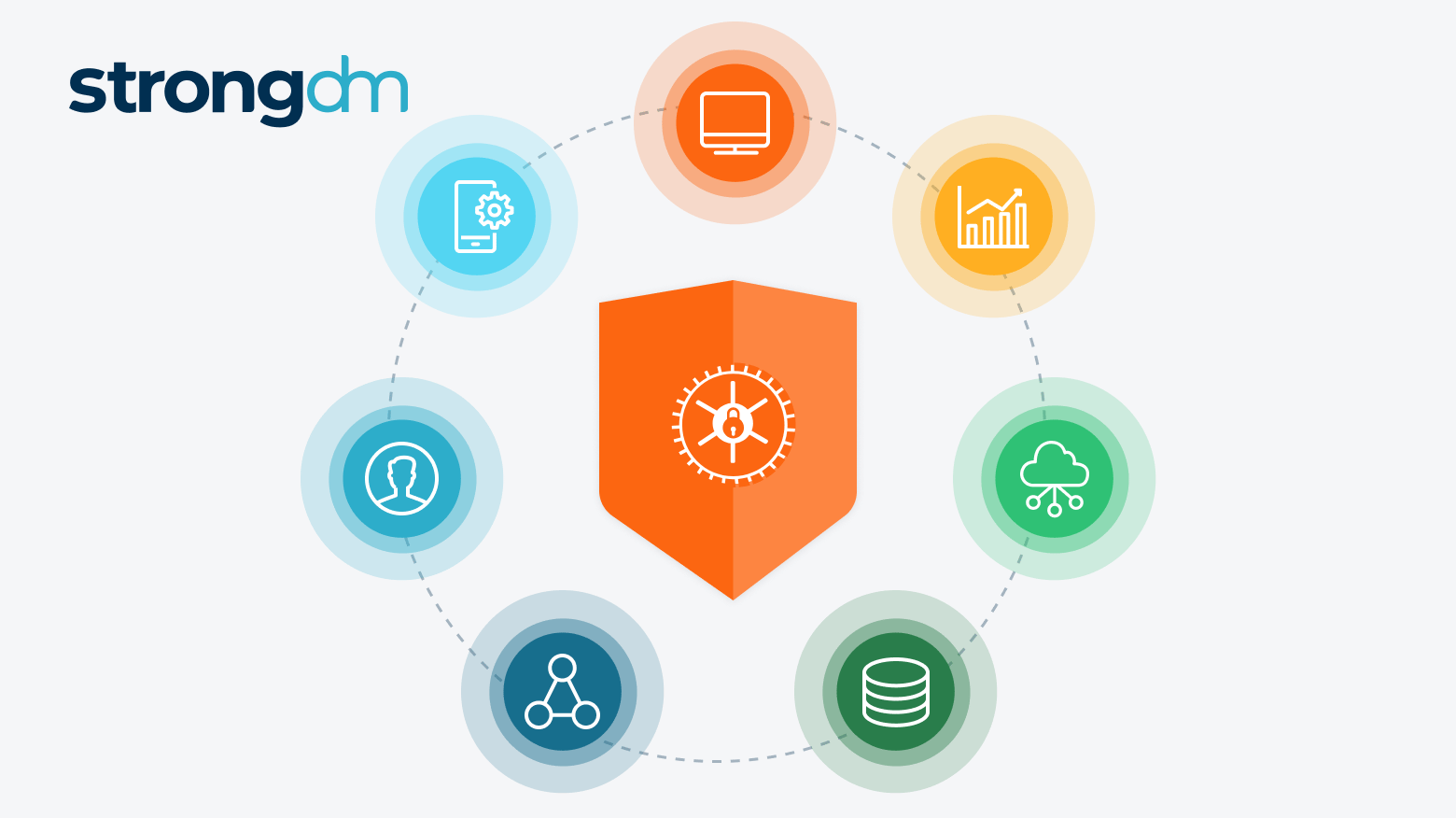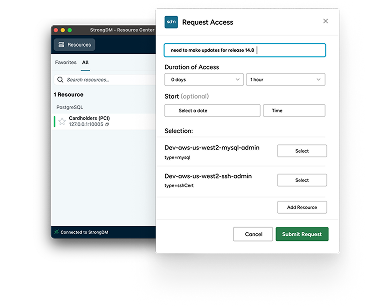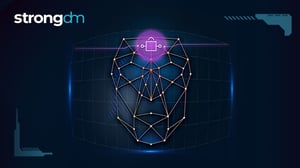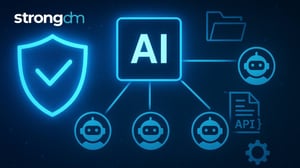
Contents
Built for Security. Loved by Devs.
- Free Trial — No Credit Card Needed
- Full Access to All Features
- Trusted by the Fortune 100, early startups, and everyone in between
For years, secrets management has revolved around one pattern: store credentials in a vault, rotate them periodically, and call it secure. But the reality of this approach is that it ultimately does precisely what it is intended to prevent. The unintended outcome of this approach is that it leaves secrets exposed the moment they’re retrieved. Enterprises that seek to adhere to Zero Trust principles can’t afford to rely on static credentials, fragmented vaults, and manual security workarounds.
Vault-based secrets management is no longer enough. Every time a credential is pulled from a vault, it introduces risk. It can be copied, cached, logged, embedded in code, or stolen before it’s even rotated. Attackers don’t need persistence—they just need a single exposed secret to do damage.
That’s why we built StrongDM Managed Secrets. It’s a solution designed to minimize credential exposure without disrupting existing workflows. It delivers vault-agnostic, Zero Trust access to Active Directory credentials, governed by granular, policy-based controls and backed by automated rotation and auditability. Whether you're working with Azure, AWS, GCP, or HashiCorp Vault, StrongDM lets you secure what you already have while preparing for what’s next.
With Managed Secrets, we’re providing a smarter and more effective way to manage secrets, one that aligns with how real organizations work today.
The Problem with Traditional Approaches to Managed Secrets
Enterprise environments are complex. They span legacy infrastructure, modern cloud platforms, and hybrid deployments—with thousands of systems, users, and automation workflows that all rely on secrets to function. Managing those secrets securely, consistently, and efficiently is one of the hardest jobs in security.
The first challenge is fragmentation. Most organizations rely on multiple secrets vaults—AWS Secrets Manager for cloud apps, HashiCorp Vault for infrastructure automation, CyberArk for privileged access, and maybe a few homegrown or legacy solutions along the way. These systems often operate in silos, making it difficult to enforce consistent access policies or generate a unified audit trail.
Secondly, enterprises have been operating with the persistent risk of credential exposure. Even with vaults in place, secrets are still retrieved and handled by users, machines, and scripts. Once a credential leaves the vault, it can be copied, cached, logged, or left behind in configuration files. Vaults don’t govern how secrets are used after retrieval—which is exactly when they become vulnerable.
Third, operational complexity slows everything down. Managing multiple vaults, writing custom automation for credential rotation, and stitching together policy enforcement across environments creates friction between security and DevOps. It forces teams into trade-offs: secure workflows that are hard to maintain, or fast workflows that are hard to secure.
Finally, enterprises face the challenge of modernizing without disruption. Many are heavily invested in Active Directory and other legacy systems. Moving to a Zero Trust model often feels like an all-or-nothing proposition—forcing painful migrations, retraining, or tool replacements that interrupt mission-critical workflows.
In short: enterprises want to secure secrets, reduce risk, and modernize their architecture—but the tools they’ve relied on until now make it hard to do all three at once.
The Realities of Secrets in Modern Environments
Secrets are everywhere—API keys, database credentials, SSH keys, AD service accounts, certificates. They’re essential to how systems authenticate and communicate. But as environments become more complex and distributed, managing those secrets securely has gone from difficult to nearly unmanageable. Security teams aren’t just dealing with one vault or one access policy—they’re dealing with sprawl, exposure, inconsistency, and fragile stopgaps that keep them in a constant state of risk mitigation.
Here are some of the painful realities teams are grappling with:
Secrets Don’t Stay in Vaults
Vaults are designed to store secrets—not to control how they’re used once retrieved. A credential pulled from a vault can be copied into a config file, cached on a developer’s laptop, or embedded in automation scripts. Even the most tightly rotated secret becomes a liability the moment it’s exposed.
Security teams are left with no visibility into how long a secret was exposed, where it ended up, or who still has access to it. Vaults log the retrieval, but not the full lifecycle of the secret once it leaves. This gap is a massive blind spot in traditional secrets management.
Secrets Are Everywhere—But Policies Are Not
Most enterprises operate in multi-vault, multi-cloud environments—each with its own access controls, audit trails, and tooling. AWS Secrets Manager, HashiCorp Vault, Azure Key Vault, CyberArk—all doing their own thing, with no centralized enforcement.
As a result, security policies are fragmented. MFA might be required in one vault, but not in another. Rotation schedules differ. Access reviews are inconsistent. This makes it nearly impossible to enforce Zero Trust principles across the board—and attackers know how to find the weakest link.
Secrets Sprawl in DevOps and Automation
In fast-moving environments, developers and automation tools need access to secrets—often at scale. To avoid delays or pipeline failures, they hardcode credentials into Terraform files, CI/CD workflows, or Kubernetes manifests. Even if pulled from a vault, those secrets often end up persisting in logs, local storage, or memory well beyond their intended use.
Security teams are left trying to bolt on controls after the fact, playing cleanup instead of prevention. It’s a constant cycle of find, revoke, rotate, repeat. And each iteration burns time and trust.
Legacy Systems Are the Roadblock to Modernization
Most large enterprises still rely on Active Directory (AD) and other on-prem systems for privileged access. These systems weren’t built for ephemeral credentials or modern identity frameworks—and many PAM tools don’t support Zero Trust natively.
Security teams know they need to modernize, but the fear of breaking critical workflows or retraining entire teams keeps them stuck. The result? Long-lived AD credentials, manually rotated and loosely governed, lurking in privileged access workflows.
Rotation Alone Isn’t Enough
Credential rotation is important, but it’s not a silver bullet. Secrets can still be compromised between rotations—and attackers only need a few minutes of access to do serious damage. Rotation solves for time-based risk; it does nothing for real-time misuse, privilege escalation, or secrets left exposed in insecure systems.
Teams end up rotating faster and auditing more—but that just adds overhead without closing the real security gaps.
Why Policy-Based Access Is Missing from Most Vaults—and Why It Matters
According to the 2024 Verizon Data Breach Investigations Report, credential-related threats remain one of the most persistent and costly issues in cybersecurity. Credential theft was involved in 38% of data breaches, with phishing and exploited vulnerabilities driving much of the activity. In fact, 71% of data compromised in basic web application attacks involved stolen credentials—highlighting just how easily secrets fall into the wrong hands.
While secrets vaults help store and retrieve credentials securely, they’re not solving the full problem. The report also points to the human element—errors, misconfigurations, and social engineering—as contributing to 68% of breaches. So even when secrets are technically protected, the context in which they’re accessed is often anything but secure.
Secrets vaults are designed to store and retrieve credentials securely, but they lack the ability to enforce fine-grained, context-aware policies around how those credentials are accessed and used. Most solutions rely on role-based access control (RBAC), which grants or denies permission to retrieve a secret based on predefined roles and permissions. While this ensures that only authorized users or applications can access secrets, it doesn’t account for the actual security context in which the access request is made.
Most secrets vaults advertise access control features—roles, permissions, maybe even token expiration. But what they don’t provide is true policy-based access—the kind of dynamic, context-aware enforcement that Zero Trust security demands.
Vaults are built around role-based access control (RBAC): assign a user or system to a group, and grant that group permission to retrieve a secret. It’s a static model in a dynamic world. Once access is granted, users or machines can retrieve the credential anytime, from anywhere, on any device—regardless of risk signals or environmental context.
This is where things break down.
Static Rules Can’t Handle Dynamic Risk
Let’s say a developer has permission to pull a database credential from a vault. The vault doesn’t care if they’re doing it during a sanctioned maintenance window or at 3 a.m. from an unrecognized IP address. It doesn’t ask for re-authentication. It doesn’t require MFA. It doesn’t flag that this credential was just retrieved five minutes ago by someone else in another region.
Vaults weren’t built to handle real-time conditions. They make binary decisions—access granted or denied—based on who you are, not what’s happening now.
One Policy Per Vault Means Inconsistent Security
In fragmented environments with multiple vaults, each system manages its own access rules—no shared policies, no unified enforcement, and no way to apply consistent security posture across the board.
This leads to a security patchwork: MFA enforced in one place but not another. Time-based restrictions configured differently per environment. Access reviews and audit trails scattered and incomplete. For organizations trying to adopt Zero Trust, this lack of centralized, policy-driven access becomes a blocker.
Legacy PAM Isn’t Built for This Either
Even traditional PAM solutions that claim “policy enforcement” typically just manage who can check out a credential and when it should be rotated. They don’t handle contextual decisions—like requiring step-up authentication before access to high-risk resources, or geo-fencing secrets access to specific regions, or ensuring credentials are only issued in the context of a pre-approved workflow.
And when it comes to secrets use in automation, forget it—once the vault issues a secret to a script or a bot, control ends.
Why It Matters
Without real policy-based access, secrets management becomes a guessing game. You’re trusting that users will behave securely, that credentials won’t be misused once retrieved, and that your audit logs will catch anything suspicious after the fact. That’s not Zero Trust. That’s wishful thinking.
Policy-based access is about shifting control from storage to usage—governing not just who can access a secret, but when, where, how, and under what conditions. It’s the missing layer between vaults and real security.
What StrongDM Managed Secrets Delivers
StrongDM Managed Secrets is designed to bring modern security principles—like Zero Trust, policy-based access, and secretless authentication—into environments where legacy systems, automation, and multi-vault complexity still dominate. It’s not just a secrets manager—it’s a smarter, more secure way to handle secrets across your entire infrastructure.
Here’s what it delivers:
Vault-Agnostic Secrets Governance
StrongDM doesn’t replace your existing vaults—it works with them.
- Supports AWS Secrets Manager, Azure Key Vault, GCP Secret Manager, HashiCorp Vault, and on-prem solutions
- No need to migrate secrets—bring your own vault and manage access securely
- Centralizes policy enforcement and audit logging across all vaults
- Eliminates vendor lock-in while supporting your infrastructure choices
Secretless Access for Humans and Machines
The best way to protect a secret? Make sure no one ever sees it.
- Secrets are never retrieved or exposed—users and machines don’t see credentials
- StrongDM injects ephemeral credentials at runtime, valid only for the duration of the session or workflow
- Supports both human and automated access, from CLI sessions to CI/CD pipelines
- Reduces the risk of credential theft, leakage, or misuse
Policy-Based, Context-Aware Access Control
Move beyond static RBAC with real-time enforcement based on security context.
- Enforce MFA, IP restrictions, time-based access windows, and device conditions
- Enable just-in-time and least-privilege access to critical resources
- Create fine-grained controls over when, how, and by whom secrets can be used
- Policies apply uniformly across all supported vaults and infrastructure
Automated AD Credential Rotation
Bridge the gap between legacy access and Zero Trust security.
- Securely store Active Directory credentials in your preferred vault
- Automatically rotate AD credentials on a schedule or on-demand
- Enforce policy-driven access to AD secrets with audit visibility
- Ideal for securing privileged access workflows in environments using vCenter, Windows servers, on-prem infrastructure, and AD-joined databases
Ephemeral Secrets for DevOps & Automation
No more hardcoded secrets. No more plain-text credentials in pipelines.
- Dynamically inject credentials into Kubernetes, Terraform, CI/CD pipelines, and cloud automation tools
- Prevent secrets from being stored in code, logs, or memory
- Reduce the burden of manually managing and rotating secrets in DevOps workflows
- Improve both speed and security in automated environments
Unified Audit Trail & Compliance Readiness
Know exactly who accessed what, when, and how—across all systems.
- Centralized audit logs of secrets access across users, machines, and environments
- Supports compliance needs like SOC 2, HIPAA, and GDPR
- Tracks secrets usage and access events in real time
- Enables faster, cleaner audits with a single source of truth
StrongDM Managed Secrets is built for the complexity of today’s enterprise IT—multi-vault, hybrid cloud, and full of legacy dependencies—and gives security teams a modern, Zero Trust way to govern secrets without breaking what already works.
It’s not just about storing secrets better. It’s about using them safely, dynamically, and on your terms.
Book a demo and see how StrongDM secures your secrets without slowing you down.
Next Steps
StrongDM unifies access management across databases, servers, clusters, and more—for IT, security, and DevOps teams.
- Learn how StrongDM works
- Book a personalized demo
- Start your free StrongDM trial

Categories:

About the Author
Amol Kabe, Chief Product Officer (CPO), spearheads the StrongDM Zero Trust PAM platform. Previously, he was the Senior Director at Google, leading the Zero Trust and Identity and Access Management portfolio for GCP. His career includes executive roles at Netskope, driving its transition from CASB to SASE, and at Riverbed Technology. Amol was also a founding member at Tablus, a pioneer in Data Loss Prevention. To contact Amol, visit him on LinkedIn.
You May Also Like




